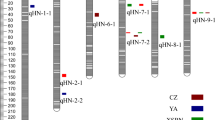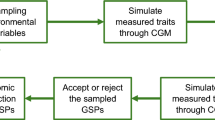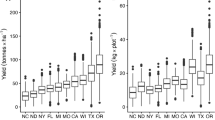Abstract
Key message
We propose the application of enviromics to breeding practice, by which the similarity among sites assessed on an “omics” scale of environmental attributes drives the prediction of unobserved genotype performances.
Abstract
Genotype by environment interaction (GEI) studies in plant breeding have focused mainly on estimating genetic parameters over a limited number of experimental trials. However, recent geographic information system (GIS) techniques have opened new frontiers for better understanding and dealing with GEI. These advances allow increasing selection accuracy across all sites of interest, including those where experimental trials have not yet been deployed. Here, we introduce the term enviromics, within an envirotypic-assisted breeding framework. In summary, likewise genotypes at DNA markers, any particular site is characterized by a set of “envirotypes” at multiple “enviromic” markers corresponding to environmental variables that may interact with the genetic background, thus providing informative breeding re-rankings for optimized decisions over different environments. Based on simulated data, we illustrate an index-based enviromics method (the “GIS–GEI”) which, due to its higher granular resolution than standard methods, allows for: (1) accurate matching of sites to their most appropriate genotypes; (2) better definition of breeding areas that have high genetic correlation to ensure selection gains across environments; and (3) efficient determination of the best sites to carry out experiments for further analyses. Environmental scenarios can also be optimized for productivity improvement and genetic resources management, especially in the current outlook of dynamic climate change. Envirotyping provides a new class of markers for genetic studies, which are fairly inexpensive, increasingly available and transferable across species. We envision a promising future for the integration of enviromics approaches into plant breeding when coupled with next-generation genotyping/phenotyping and powerful statistical modeling of genetic diversity.






Similar content being viewed by others
Availability of data and materials
This article is the peer-reviewed version of the preprint posted august 06, 2019 at: https://doi.org/10.1101/726513. Code used to generate the simulated data, and the envirotypic (File S1) and phenotypic data (File S2) are available in the repository: https://figshare.com/articles/Enviromics_data/8264132.
References
Acosta-Pech R, Crossa J, de los Campos G et al (2017) Genomic models with genotype × environment interaction for predicting hybrid performance: an application in maize hybrids. Theor Appl Genet 130:1431–1440
Annicchiarico P, Bellah F, Chiari T (2006) Repeatable genotype × location interaction and its exploitation by conventional and GIS-based cultivar recommendation for durum wheat in Algeria. Eur J Agron 24:70–81
Annicchiarico P, Bellah F, Chiari T (2005) Defining subregions and estimating benefits for a specific-adaptation strategy by breeding programs. Crop Sci 45:1741–1749
Annicchiarico P, Iannucci A (2008) Breeding strategy for faba bean in southern Europe based on cultivar responses across climatically contrasting environments. Crop Sci 48:983–991
Asseng S, Ewert F, Rosenzweig C et al (2013) Uncertainty in simulating wheat yields under climate change. Nat Clim Chang 3:827
Bänziger M, Edmeades GO, Beck D, Bellon M (2000) Breeding for drought and nitrogen stress tolerance in maize: from theory to practice. Cimmyt, Mexico
Beckers J, Wurst W, de Angelis MH (2009) Towards better mouse models: enhanced genotypes, systemic phenotyping and envirotype modelling. Nature Rev Genet 10(6):371–380
Bustos-Korts D, Boer MP, Malosetti M et al (2019) Combining crop growth modelling and statistical genetic modelling to evaluate phenotyping strategies. Front Plant Sci 10:1491
Calus MPL, Bijma P, Veerkamp RF (2004) Effects of data structure on the estimation of covariance functions to describe genotype by environment interactions in a reaction norm model. Genet Sel Evol 36:489
Cappa EP, El-Kassaby YA, Muñoz F et al (2017) Improving accuracy of breeding values by incorporating genomic information in spatial-competition mixed models. Mol Breed 37:125
Chang J-H (2017) Climate and agriculture: An ecological survey, 1st edn. Routledge, New York, USA
Chapman SC, Hammer GL, Butler DG, Cooper M (2000) Genotype by environment interactions affecting grain sorghum. III. Temporal sequences and spatial patterns in the target population of environments. Aust J Agric Res 51:223–234
Cobb JN, DeClerck G, Greenberg A et al (2013) Next-generation phenotyping: requirements and strategies for enhancing our understanding of genotype–phenotype relationships and its relevance to crop improvement. Theor Appl Genet 126:867–887
Cooper M, Messina CD, Podlich D et al (2014) Predicting the future of plant breeding: complementing empirical evaluation with genetic prediction. Crop Pasture Sci 65:311–336
Costa-Neto GMF, Júnior OPM, Heinemann AB et al (2020) A novel GIS-based tool to reveal spatial trends in reaction norm: upland rice case study. Euphytica 216:37
Covarrubias-Pazaran G (2016) Genome-assisted prediction of quantitative traits using the R package sommer. PLoS ONE 11:1–15
Des Marais DL, Hernandez KM, Juenger TE (2013) Genotype-by-environment interaction and plasticity: exploring genomic responses of plants to the abiotic environment. Annu Rev Ecol Evol Syst 44:5–29
Eberhart SA, Russell WA (1966) Stability parameters for comparing varieties. Crop Sci 6:36–40
Editorial (2015) Growing access to phenotype data. Nat Genet 47:99
El-Kassaby YA, Lstibůrek M (2009) Breeding without breeding. Genet Res (Camb) 91:111–120
Elias AA, Robbins KR, Doerge RW, Tuinstra MR (2016) Half a century of studying genotype × environment interactions in plant breeding experiments. Crop Sci 56:2090–2105
Fernandes AFA, Alvarenga ÉR, Alves GFO et al (2019) Genotype by environment interaction across time for Nile tilapia, from juvenile to finishing stages, reared in different production systems. Aquaculture 513:734429
Ferrero-Serrano Á, Assmann SM (2019) Phenotypic and genome-wide association with the local environment of Arabidopsis. Nat Ecol Evol 3:274–285
Fick SE, Hijmans RJ (2017) WorldClim 2: new 1-km spatial resolution climate surfaces for global land areas. Int J Climatol 37:4302–4315
Finlay KW, Wilkinson GN (1963) The analysis of adaptation in a plant-breeding programme. Aust J Agric Res 14:742–754
Gad SC (2008) Preclinical development handbook: toxicology. Wiley, New York, USA
Garnett T, Appleby MC, Balmford A et al (2013) Sustainable intensification in agriculture: premises and policies. Science 341:33–34. https://doi.org/10.1126/science.1234485
Gauch H, Zobel RW (1997) Identifying mega-environments and targeting genotypes. Crop Sci 37:311–326
Gauch HG (2006) Statistical analysis of yield trials by AMMI and GGE. Crop Sci 46:1488–1500
Gianola D, de los Campos G, Hill WG et al (2009) Additive genetic variability and the Bayesian alphabet. Genetics 183:347–363
Gianola D, Rosa GJM (2015) One hundred years of statistical developments in animal breeding. Annu Rev Anim Biosci 3:19–56
Giles JR, Peterson AT, Busch JD et al (2014) Invasive potential of cattle fever ticks in the southern United States. Parasit Vectors 7:1–11
Gomez-Raya L, Burnside EB (1990) The effect of repeated cycles of selection on genetic variance, heritability, and response. Theor Appl Genet 79:568–574
González-Barrios P, Díaz-García L, Gutiérrez L (2019) Mega-environmental design: using genotype × environment interaction to optimize resources for cultivar testing. Crop Sci 59:1899–1915
Haghighattalab A, Crain J, Mondal S et al (2017) Application of geographically weighted regression to improve grain yield prediction from unmanned aerial system imagery. Crop Sci 57:2478–2489
Hartemink AE (2015) The use of soil classification in journal papers between 1975 and 2014. Geoderma Reg 5:127–139
Houle D, Govindaraju DR, Omholt S (2010) Phenomics: the next challenge. Nat Rev Genet 11:855
Hyman G, Hodson D, Jones P (2013) Spatial analysis to support geographic targeting of genotypes to environments. Front Physiol 4:1–13
Jannink J-L, Lorenz AJ, Iwata H (2010) Genomic selection in plant breeding: from theory to practice. Brief Funct Genomics 9:166–177
Jarquín D, Crossa J, Lacaze X et al (2014) A reaction norm model for genomic selection using high-dimensional genomic and environmental data. Theor Appl Genet 127:595–607
Kasampalis DA, Alexandridis TK, Deva C et al (2018) Contribution of remote sensing on crop models: a review. J Imaging 4:52
Kleinknecht K, Möhring J, Singh KP et al (2013) Comparison of the performance of best linear unbiased estimation and best linear unbiased prediction of genotype effects from zoned Indian maize data. Crop Sci 53:1384–1391
Koch J, Stisen S, Refsgaard JC et al (2019) Modeling depth of the redox interface at high resolution at national scale using random forest and residual gaussian simulation. Water Resour Res 55:1451–1469
Kohavi R (1995) A study of cross-validation and bootstrap for accuracy estimation and model selection. In: Ijcai. pp 1137–1145
Kottek M, Grieser J, Beck C et al (2006) World map of the Köppen-Geiger climate classification updated. Meteorol Zeitschrift 15:259–263
Liaw A, Wiener M (2002) Classification and regression by randomForest. R news 2:18–22
Lindblom J, Lundström C, Ljung M, Jonsson A (2017) Promoting sustainable intensification in precision agriculture: review of decision support systems development and strategies. Precis Agric 18:309–331
Löffler CM, Wei J, Fast T et al (2005) Classification of maize environments using crop simulation and geographic information systems. Crop Sci 45:1708–1716
Malosetti M, Bustos-Korts D, Boer MP, van Eeuwijk FA (2016) Predicting responses in multiple environments: issues in relation to genotype × environment interactions. Crop Sci 56:2210–2222
Marcatti GE, Resende RT, Resende MDV et al (2017) GIS-based approach applied to optimizing recommendations of Eucalyptus genotypes. For Ecol Manage 392:144–153
Matise TC, Ambite JL, Buyske S et al (2011) The Next PAGE in understanding complex traits: design for the analysis of Population Architecture Using Genetics and Epidemiology (PAGE) Study. Am J Epidemiol 174:849–859
McKown AD, Klápště J, Guy RD et al (2014) Genome-wide association implicates numerous genes underlying ecological trait variation in natural populations of Populus trichocarpa. New Phytol 203:535–553
Millet EJ, Kruijer W, Coupel-Ledru A et al (2019) Genomic prediction of maize yield across European environmental conditions. Nat Genet 51:952–956
Moehring J, Williams ER, Piepho H-P (2014) Efficiency of augmented p-rep designs in multi-environmental trials. Theor Appl Genet 127:1049–1060
Mota LFM, Lopes FB, Júnior GAF et al (2020) Genome-wide scan highlights the role of candidate genes on phenotypic plasticity for age at first calving in nellore heifers. Sci Rep 10:1–13
Mullin TJ (2017) OPSEL 2.0: a computer program for optimal selection in tree breeding, 1st edn. Skogforsk, Uppsala, Sweden
Nicotra AB, Atkin OK, Bonser SP et al (2010) Plant phenotypic plasticity in a changing climate. Trends Plant Sci 15:684–692
Oliver MA, Webster R (2015) Basic steps in geostatistics: the variogram and kriging. Springer, Berlin
Pérez-Rodríguez P, Crossa J, Bondalapati K et al (2015) A pedigree-based reaction norm model for prediction of cotton yield in multienvironment trials. Crop Sci 55:1143–1151
Pérez-Rodríguez P, Crossa J, Rutkoski J et al (2017) Single-step genomic and pedigree genotype × environment interaction models for predicting wheat lines in international environments. Plant Genome 10:1–15
Piepho H-P, Denis J-B, van Eeuwijk FA (1998) Predicting cultivar differences using covariates. J Agric Biol Environ Stat 151–162
Poschenrieder C, Gunsé B, Corrales I, Barceló J (2008) A glance into aluminum toxicity and resistance in plants. Sci Total Environ 400:356–368
Rauw WM, Gomez-Raya L (2015) Genotype by environment interaction and breeding for robustness in livestock. Front Genet 6:310
Raza A, Razzaq A, Mehmood SS et al (2019) Impact of climate change on crops adaptation and strategies to tackle its outcome: A review. Plants 8:34
Resende MDV, Rezende GDSP, Fernandes JSC (2001) Regressão aleatória e funções de covariância na análise de medidas repetidas. Rev Mat Estat 19:21–40
Resende RT, Soares AAV, Forrester DI et al (2018) Environmental uniformity, site quality and tree competition interact to determine stand productivity of clonal Eucalyptus. For Ecol Manage 410:76–83
Ribeiro S, Eler JP, Pedrosa VB et al (2015) Genotype × environment interaction for weaning weight in Nellore cattle using reaction norm analysis. Livest Sci 176:40–46
Riggs DW, Yeager RA, Bhatnagar A (2018) Defining the human envirome: an omics approach for assessing the environmental risk of cardiovascular disease. Circ Res 122:1259–1275
Schmidt P, Hartung J, Rath J, Piepho H-P (2019) Estimating broad-sense heritability with unbalanced data from agricultural cultivar trials. Crop Sci 59:525–536
Schmidt P, Möhring J, Koch RJ, Piepho H-P (2018) More, larger, simpler: How comparable are on-farm and on-station trials for cultivar evaluation? Crop Sci 58:1508–1518
Shakoor N, Lee S, Mockler TC (2017) High throughput phenotyping to accelerate crop breeding and monitoring of diseases in the field. Curr Opin Plant Biol 38:184–192
Sorensen D, Gianola D (2002) Likelihood, Bayesian, and MCMC methods in quantitative genetics, 1st edn. Springer Science & Business Media, New York
Sukumaran S, Crossa J, Jarquín D, Reynolds M (2017) Pedigree-based prediction models with genotype × environment interaction in multienvironment trials of CIMMYT wheat. Crop Sci 57:1865–1880
Teixeira AP, Dias JML, Carinhas N et al (2011) Cell functional enviromics: unravelling the function of environmental factors. BMC Syst Biol 5:92
van Eeuwijk FA, Bustos-Korts D, Millet EJ et al (2018) Modelling strategies for assessing and increasing the effectiveness of new phenotyping techniques in plant breeding. Plant Sci 282:23–39
van Eeuwijk FA, Bustos-Korts DV, Malosetti M (2016) What should students in plant breeding know about the statistical aspects of genotype × environment interactions? Crop Sci 56:2119–2140
van Ginkel M, Ortiz R (2017) Cross the best with the best, and select the best: HELP in breeding selfing crops. Crop Sci 58:17–30
Varona L, Munilla S, Mouresan EF et al (2015) A Bayesian model for the analysis of transgenerational epigenetic variation. G3 Genes. Genomes, Genet 5:477–485
Velazco JG, Rodríguez-Álvarez MX, Boer MP et al (2017) Modelling spatial trends in sorghum breeding field trials using a two-dimensional P-spline mixed model. Theor Appl Genet 130:1375–1392
Vilhena DA, Antonelli A (2015) A network approach for identifying and delimiting biogeographical regions. Nat Commun 6:6848
Voss-Fels KP, Cooper M, Hayes BJ (2019) Accelerating crop genetic gains with genomic selection. Theor Appl Genet 132:669–686
Wolfert S, Ge L, Verdouw C, Bogaardt M-J (2017) Big data in smart farming–a review. Agric Syst 153:69–80
Xu Y (2016) Envirotyping for deciphering environmental impacts on crop plants. Theor Appl Genet 129:653–673
Xue J, Su B (2017) Significant remote sensing vegetation indices: A review of developments and applications. J Sensors 2017:1–17
Yan W, Hunt LA, Sheng Q, Szlavnics Z (2000) Cultivar evaluation and mega-environment investigation based on the GGE biplot. Crop Sci 40:597–605
Acknowledgements
We would like to acknowledge professors Gustavo E. Marcatti from UFSJ and Helio G. Leite from UFV for their valuable input regarding the use of GIS and landscape level plant management data. We also want to thank the editor Martin P. Boer and the four anonymous reviewers for their considerations and suggestions to improve the manuscript. This work was partly supported by a postdoctoral grant (project FAP-DF 0193.001198/2016) to RTR (grant 4026592013-9), DFG grant (PI 377/20-1) to HPP, and infrastructure funding from the Brazilian Council for Scientific and Technological Development (CNPq/PQ 307096/2018-1).
Author information
Authors and Affiliations
Contributions
RTR, HPP, OBSJ, GJMR and FFS were involved in simulation and data analysis. MDVR, RTR, HPP, GJMR and FFS developed mathematical–statistical procedures and notations. RTR, HPP, GJMR, OBSJ, FFS and DG wrote the manuscript. All authors reviewed the manuscript.
Corresponding authors
Ethics declarations
Conflict of interest
On behalf of all authors, the corresponding author states that there is no conflict of interest.
Additional information
Communicated by Martin Boer.
Publisher's Note
Springer Nature remains neutral with regard to jurisdictional claims in published maps and institutional affiliations.
Rights and permissions
About this article
Cite this article
Resende, R.T., Piepho, HP., Rosa, G.J.M. et al. Enviromics in breeding: applications and perspectives on envirotypic-assisted selection. Theor Appl Genet 134, 95–112 (2021). https://doi.org/10.1007/s00122-020-03684-z
Received:
Accepted:
Published:
Issue Date:
DOI: https://doi.org/10.1007/s00122-020-03684-z




